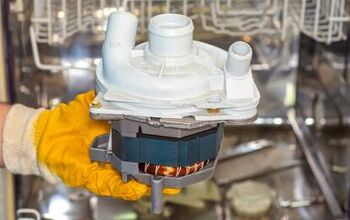How To Lengthen A Dishwasher Drain Hose

Dishwashers can make life just a little bit easier. No matter if you are hosting a large party or cooking for yourself, doing the dishes is rarely an endeavor that one wants to undertake. Having a dishwasher means being able to rinse the dishes quickly and put them in the dishwasher to clean.
There is a hose that runs from the dishwasher and into your sewer system, pumping the water out. In some cases, there may be a desire to lengthen that hose. This step-by-step guide will show you how to properly lengthen that hose.
Do You Need Appliance Installation or Replacement?
Get free, zero-commitment quotes from pro contractors near you.

How Do You Lengthen A Dishwasher Drain Hose?
Step 1: Measure Your Drain Pipe
If you haven’t done this already, measure the outer diameter of the drain pipe. You’ll want to measure from one outside edge through the center and to the opposite outside edge. This will let you know how big your extension has to be.
Buy the appropriate size fitting and get a flexible drain covering that will fit over top of it. You can grab these at a local hardware store, a plumbing store, and online pretty easily.
Step 2: Turn Off the Power
A good rule of thumb when working with any electronic appliance is to turn off the power. Electrical shocks are definitely no small matter and it is important to protect yourself whenever possible. Start by unplugging the dishwasher.
You can go a step further by cutting off the power for the dishwasher at the main circuit. Simply flip the breaker for that outlet and you can be 100% certain that there is no power being generated by the dishwasher.
Step 3: Locate the Hose and Loosen It
When the power is off and you are certain that the conditions are safe to work in, it is time to locate the end of the drain hose that attaches beneath the sink. You’ll find it either connected to the garbage disposal under the sink or to a tailpiece that is located right beneath the drain. It all depends on your specific installation.
When you’ve located the end of your hose, you will need to loosen the hose clamp that holds it into place. This can be done using a simple screwdriver; make sure that you keep all of the appropriate screws to put it back into place later on.
Step 4: Attach the Coupling
Using your drain coupling, it is time to attach both the existing drain hose and the new piece. On one end, place the coupling over a piece of drainpipe. You should see that there is a notch on the inside that limits the positioning of the pipe to right around the halfway point.
After tightening the hose clamp until it is firm – providing a leakproof and waterproof seal – you insert your extension into the other side of the coupling. Keep going until it makes contact and ends up stopping at the halfway point. Finish it up by tightening down the hose clamp.
Step 5: Reconnecting and Restoring Power
When you’re confident that you’ve made the connection and finished the extension, it is time to reconnect your hose. Connect it back to the point underneath your sink where you found it and reapply the coverings. Make sure that everything has been secured properly.
When you’re confident that everything has been restored, move the dishwasher back into place and restore the power. You can do a test run with no dishes to ensure that there are no leaks and that the hose extension is working properly. If you notice any leaking, go back through the steps and ensure that all of the connections are tightened securely.
Dishwasher Drain Hose Extension Kit
Can a Dishwasher Drain Hose be too Long?
The short answer is yes. The longer the length of the hose, the greater the risk for kinking in the hose. When there are kinks or interruptions in the hose, it can prevent proper drainage and create a backlog of water in the hose.
You want the hose to be long enough but with only a little bit of slack. This will allow for proper drainage as your hose won’t kick. Blockages can create major issues and even lead to leaks or bursts that can create water damage in any local cabinetry.
How High Should a Dishwasher Drain Hose Be?
As a rule of thumb, it is a good idea that dishwasher hoses have the high loop be at least 20 inches above any finished flooring. The reason for this is to prevent any of the wastewater from entering the appliance itself should the drain wind up clogging.
Most building codes dictate that the hose be connected at the sink drain. The connection should be on the sink side of the trap and should typically use a branch tailpiece to make the connection. But building codes can vary based on area, so check with your municipality first if you have any questions.
Do New Dishwashers Need an Air Gap?
The short answer to this question is yes. The most common way to create an air gap for a new dishwasher. You can do this by creating a high loop in your connecting or drain hose to a fitting that can mount to the top portion of your sink or countertop. There are guides on how to create this loop if you aren’t sure how.
Depending on the area, that high loop will be the absolute minimum requirement. In most other places, though, you will need that air gap to be installed whenever you install a new dishwasher, so keep that in mind.
How Often Should You Change Dishwasher Hoses?
A good rule of thumb is to replace your dishwasher hoses after five years. This is even if there are no obvious signs of degradation or wear and tear. Even if you can’t see signs, there are internal wear and tear issues that can lead to leaks and bursts.
It is also a good idea to use a hose that is made of reinforced steel and braided. These are extra strong, extra durable, and are far less likely to fail. They will still need to be replaced at that five-year mark, but you should be worry-free in that time.
Are Dishwasher Drain Hoses Universal?
Generally speaking, just about any dishwasher hose that you use can be applied universally. The universal dishwasher drain hose can be implemented to connect just about any brand of dishwashers to your sink’s drain.
There are also universal extensions that can be implemented for just about any hose or sink to provide the necessary hose extension.
Do You Need Appliance Installation or Replacement?
Get free, zero-commitment quotes from pro contractors near you.

Can I run My Dishwasher if My Sink is Clogged?
While it may be physically possible for your dishwasher to run while it is clogged, it may not be the best idea. When the sink or disposal is clogged, there is a good chance that the dishwasher will not drain properly.
When your dishwasher doesn’t drain properly, water and debris can back up into the dishwasher. This can not only lead to dishes failing to clean but can also potentially damage the dishwasher and its components over time. If you are aware of any clogging issues, be sure to clear those out before you use the dishwasher again. You may notice a backup if your sink isn’t draining properly, either.
Related Guides

Ryan Womeldorf has more than a decade of experience writing. He loves to blog about construction, plumbing, and other home topics. Ryan also loves hockey and a lifelong Buffalo sports fan.
More by Ryan Womeldorf



























